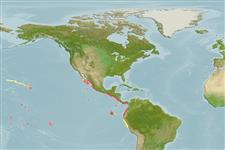Teleostei (teleosts) >
Aulopiformes (Grinners) >
Synodontidae (Lizardfishes) > Synodontinae
Etymology: Synodus: Greek, syn, symphysis = grown together + Greek, odous = teeth (Ref. 45335).
Eponymy: Dr Barton Warren Evermann (1853–1932) was a schoolteacher (1876–1886) and a student at Indiana University, where he was awarded his bachelor’s degree (1886), master’s (1888) and doctorate (1891). [...] (Ref. 128868), visit book page.
More on authors: Jordan & Bollman.
Environment: milieu / climate zone / depth range / distribution range
Ecology
Marine; demersal; depth range 25 - 275 m (Ref. 9348). Tropical; 27°N - 13°S
Eastern Pacific: Mazatlán, Mexico to Chilca, Peru.
Size / Weight / Age
Maturity: Lm ? range ? - ? cm
Max length : 47.2 cm TL male/unsexed; (Ref. 124487); common length : 20.0 cm TL male/unsexed; (Ref. 9348); max. published weight: 538.93 g (Ref. 124487)
Found on soft bottoms (Ref. 9348).
Life cycle and mating behavior
Maturity | Reproduction | Spawning | Eggs | Fecundity | Larvae
Bussing, W.A. and R.J. Lavenberg, 1995. Synodontidae. Lagartos. p. 1625-1628. In W. Fischer, F. Krupp, W. Schneider, C. Sommer, K.E. Carpenter and V. Niem (eds.) Guia FAO para Identification de Especies para lo Fines de la Pesca. Pacifico Centro-Oriental. 3 Vols. FAO, Rome. (Ref. 9348)
IUCN Red List Status (Ref. 130435: Version 2024-1)
Threat to humans
Harmless
Human uses
Tools
Special reports
Download XML
Internet sources
Estimates based on models
Preferred temperature (Ref.
123201): 13.2 - 21.6, mean 15.4 °C (based on 52 cells).
Phylogenetic diversity index (Ref.
82804): PD
50 = 0.5000 [Uniqueness, from 0.5 = low to 2.0 = high].
Bayesian length-weight: a=0.00537 (0.00339 - 0.00851), b=3.07 (2.94 - 3.20), in cm total length, based on LWR estimates for this species & Genus-body shape (Ref.
93245).
Trophic level (Ref.
69278): 4.4 ±0.7 se; based on size and trophs of closest relatives
Resilience (Ref.
120179): Medium, minimum population doubling time 1.4 - 4.4 years (Preliminary K or Fecundity.).
Fishing Vulnerability (Ref.
59153): Moderate vulnerability (37 of 100).
